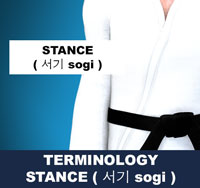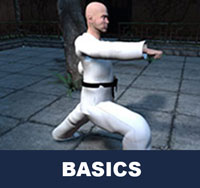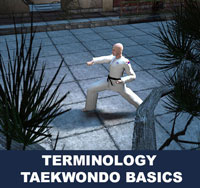Taekwondo 태권도Taekwondo Preschool
Taekwondo is known for its emphasis on high kicking and fast hand techniques, which distinguishes it from other popular martial arts and combat sports such as karate. However, the World Taekwondo (WT) believes that because the leg is the longest and strongest limb a martial artist has, kicks thus have the greatest potential to execute powerful strikes without successful retaliation.
View Taekwondo 태권도 »

Stances ( 서기 sogi ) Terminology
In taekwondo, Korean language is often used. During tests practitioners are usually asked what certain Korean words used in class mean. These words are fairly common amongst taekwondo schools, but accuracy of pronunciation can vary greatly.
Taekwondo can also be a great way to learn the Korean language by engaging in conversations with practitioners while at school. Here is a basic list of commonly used words that might be expected. Knowing the fundamental basics is very important for your learning path as you build your skills and knowledge. When you reach senior belt you are expected to guide the junior belts when they are beginning Taekwondo such as showing by example.
View all taekwondo stances on the Main Stances ( 서기 sogi ) Section »
| Hangul 한글 | Korean | Belt Requirement | Difficulty Level | Tutorial | |
| Attention Stance | 차렷 | charyeot |   |
Beginner Level | Tutorial » |
| Ready Stance | 기본준비 | junbi |   |
Beginner Level | Tutorial » |
| Front Stance | 앞굽이 | ap-kubi |   |
Beginner Level | Tutorial » |
| Horse Riding Stance | 주춤서기 | juchum-sogi |   |
Beginner Level | Tutorial » |
| Two Fist Ready Posture | 두주먹허리준비 | dujumeok-heori-junbi |   |
Beginner Level | Tutorial » |
| Fighting Stance | 겨루기준비 | gyeorugi-junbi |    |
Beginner Level | Tutorial » |
| Walking Stance | 앞서기 | ap-sogi |   |
Beginner Level | Tutorial » |
| Parallel Stance | 나란히서기 | naranhi-sogi |   |
Beginner Level | Tutorial » |
| Inward Stance | 안쫑서기 | anjjong-sogi |   |
Beginner Level | Tutorial » |
| At Ease Stance | 편히서기 | pyeoni-sogi |   |
Beginner Level | Tutorial » |
| Back Stance | 뒷굽이 | dwi-kubi |    |
Intermediate Level | Tutorial » |
| Side Stance | 옆서기 | yeop-sogi |  |
Intermediate Level | |
| Left Stance ”L” Shape | 왼 서기 | wen-sogi |  |
Intermediate Level | Tutorial » |
| Right Stance ”L” Shape | 오른 서기 | oreun-sogi |  |
Intermediate Level | Tutorial » |
| Cross Stance | 꼬아서기 | koa-sogi |   |
Intermediate Level | |
| Rear Cross Stance | 뒤 꼬아서기 | dwi-koa-sogi |   |
Intermediate Level | Tutorial » |
| Covered Fist Posture | 보주먹준비 | bojumeok-junbi |  |
Intermediate Level | Tutorial » |
| Tiger / Cat Stance | 범서기 | beom-sogi |   |
Intermediate Level | Tutorial » |
| Forward Cross Stance | 앞 꼬아서기 | ap-koa-sogi |   |
Intermediate Level | Tutorial » |
| ‘ㅗ’ Shape Stance | ‘ㅗ’ 자 서기 | oja-sogi |   |
Advanced Level | |
| Log Pushing Hands Posture | 통밀기준비 | tongmilgi-junbi |   |
Advanced Level | Tutorial » |
| Crane Stance | 학다리서기 | hakdari-sogi |  |
Advanced Level | Tutorial » |
| Overlapped-Hand Posture | 겹손준비 | gyeopson-junbi |  |
Advanced Level | Tutorial » |
| Inner Knee Stance | 오금서기 | ogum-sogi |  |
Advanced Level | Tutorial » |
| Assisting Stance | 곁다리서기 | gyeotdari-sogi |  |
Advanced Level | Tutorial » |

Taekwondo Basics
Here is where you can learn more about Taekwondo 태권도. Knowing the fundamental basics is very important for your learning path as you build your skills and knowledge. There are certain rules that need to be followed to show respect to the master ( 사범님 sabeomnim ), the instructors ( 교사님 gyosannim ), other practitioners and to the martial arts. They vary between schools but many have similar rules and guidelines. For more information View Taekwondo Basics »
There are five tenets defined in the International Taekwondo Federation (ITF) and several more in World Taekwondo (WT).
Indomitable Spirit ( 백절불굴 baekjul-boolgool ): "To have indomitable spirit means to have the courage to stand up for what you believe in, no matter what odds you are up against, and to always give 100% effort in whatever you do." View Taekwondo Tenets »
RESOURCES
This article uses material from the Wikipedia articles "List of Taekwondo Techniques" and "Taekwondo Stances", which is released under the Creative Commons Attribution-Share-Alike License 3.0.

















